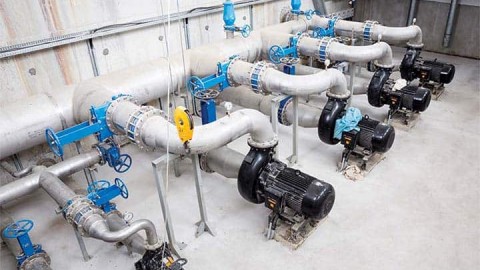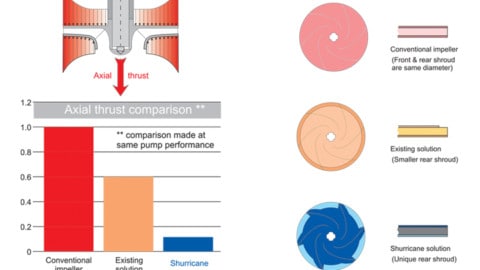A flow meter is an instrument that is used to indicate the amount of liquid, gas, or vapour moving through a pipe or conduit and there are a number of considerations to take into account when selecting the type of flow meter that is best suited to your application. Here, we break down the different types of flow meters and how they work.
There are several types of flow meter available on the market, each measuring flow rate in a different way, but most are integrated into a pipe and inserted into the stream or flow. Each type of flow meter has advantages and disadvantages, which will need to be considered when selecting the one that will best suit your application.
There are five main types of flow meters on the market.
Differential pressure flow meters
These are one of the most common types of flow meter, and their design is based on scientific principles that govern the way fluids, both liquids and gases, flow through pipes. In order for a consistent flow rate to be maintained, a fluid moving from a wider pipe to a smaller one will need to move with greater velocity. When the velocity of the fluid increases, the pressure decreases.
Therefore, using the Bernoulli Equation, the flow rate can be accurately measured based on the differential pressure. As the scientific principle that these flow meters are based on suggests, the fluid being measured enters a narrower section of pipe, sometimes by way of an orifice plate, and the flow meter flowmeter measures the difference in pressure that occurs as a result of the flow-restricted area.
These flow meters are common in many industries where the flow rate of the fluid needs to be measured, including oil and gas,
water, pharmaceutical, food and beverage, mining, chemicals and HVAC, among others. Sub-types of differential pressure flow meters are orifice plates, flow nozzles, venturi flow meters and rotameters.
Velocity flow meters
Velocity flow meters calculate flow speed by measuring the depth and average air velocity of the flow. They calculate this using the flow meter working principle that the flow rate of a fluid is equal to a cross-section of the pipe multiplied by the fluid’s velocity.
These flow meters have a greater range than differential pressure flow meters. Types of velocity flow meters include pilot tube, calorimetric, turbine, vortex, paddlewheel, ultrasonic and electromagnetic.
Positive displacement flow meters
Positive displacement (PD) flow meters measure viscous liquid flow using rotors as sensors. These are the only type of flow meter that calculate a fluid’s flow rate by measuring the volume of fluid that comes through the meter, rather than measuring some other aspect of the fluid that relates to flow rate.
PD flow meters are used in applications where straight pipe is not available, or where there is too much turbulence in the flow for other types of flow meter to be used such as turbine meters or paddlewheel sensors. The exact way these flow meters measure the rate at which the rotating components turn can vary.
For example, magnets can be included in the components to trigger sensors outside the fluid chamber. PD flow meters have a wellestablished reputation for accuracy due to their ability to measure high and varying viscosities. Variations in temperature can change the viscosity of a liquid being measured, which can cause inaccuracy in other technologies.
PD flow meters measure discrete volumes with each pulse and account for nearly all the fluid that passes through, reducing slippage and making them ideal for more viscous fluids.
Mass flow meters
Mass flow meters are often the meter of choice when working with a very viscous substance, and are common in the pharmaceutical, mining, wastewater, power and chemical and gas industries.
This type of flow meter measures the mass flow of fluid as it moves through a pipe, either by heating a section of fluid and noting the resulting change in temperature or keeping a probe at a constant temperature and recording the amount of energy the probe requires to do this.
The most common choice for liquid application is the Coriolis mass flow meter, which measures the mass rate of flow directly as opposed to volumetric flow and is particularly useful for measuring liquids with viscosities that vary with velocity, temperatures and pressures.
Mass flowmeters that use heat to measure mass flow are called thermal dispersion flow meters. These have traditionally been used for gas measurements, but designs for liquid flow measurements are available. Thermal dispersion flow meters use a heated sensing element isolated from the fluid flow path, which conducts heat from the sensing element.
The conducted heat is directly proportional to the mass flow rate. Regardless of which method your meter uses to measure mass flow rate, you should note there is a difference in mass flow rate and volumetric flow rate. While a positive displacement flowmeter measures the volume of fluid, a mass flow meter measures the mass of the fluid that travels through.
However, a measure of mass flow rate can determine the volumetric flow rate of a fluid. By dividing the mass flow rate by the density of the fluid, a mass flow meter can determine the flow rate in terms of volume.
Open channel flow meters
Lastly, there are open channel flow meters, which include a dam-like structure called a primary device. The primary device can be either a weir or a flume; the difference being largely the shape. Weirs are openings at the top of a dam that are either rectangular or V-shaped and as the fluid flows over the dam, through the weir, the height of the fluid will increase and a greater increase in depth indicates a higher flow rate.
Flumes, on the other hand, provide a constriction in width rather than height. As the fluid enters the narrower section of the channel, the water level changes, again correlating to the flow rate. Open channel flow meters are a useful means of measuring the flow rate in free-flowing bodies of water such as streams and water, and play a large role in water and wastewater treatment applications.

















